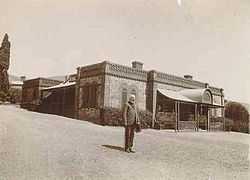Samuel Davenport
| Sir Samuel Davenport | |
|---|---|
 1895 portrait of Samuel Davenport | |
| Born |
5 March 1818 Shirburn, Oxfordshire, England |
| Died |
3 September 1906 (aged 88) Beaumont, South Australia, Australia |
| Occupation | Parliamentarian, landowner, agriculturalist |
| Spouse(s) | Margaret Fraser |
| Children | None |
| Parents | George Davenport and Jane Devereux, née Davies |
Sir Samuel Davenport KCMG (5 March 1818 – 3 September 1906) was one of the early settlers of Australia and became a landowner and parliamentarian in South Australia.
He was fourth son of George Davenport, a wealthy English banker, and his wife Jane Devereux, née Davies, and was educated at Mill Hill School in North London. His father, had become an agent of the South Australia Company in England and together with partners Frederick Luck (quarter share) and Roger Cunliffe (one-eighth share) paid £4416 for a special survey of 4,416 acres (17.87 km2) in South Australia. George Davenport sent his eldest son Francis to select the land, and Francis arrived in Adelaide in February 1840. After initially considering land near Port Lincoln, he selected land on the upper reaches of the River Angas, including what is now the town of Macclesfield. Francis returned to England in 1841, leaving Henry Giles to manage his affairs.
Samuel married Margaret Fraser Cleland (1821 – 6 February 1902) on 1 June 1842. She was to become a noted philanthropist, closely associated with Emily Clark, Lady Colton and Catherine Helen Spence.[1]
Samuel, his wife and another brother Robert went to Australia in February 1843 accompanying Francis and his wife Sarah on their return. Francis died on 8 April 1843, and the remaining brothers lived at Macclesfield and managed the survey. Samuel continued to receive an annual allowance from his father.
Davenport's first ventures after moving to Australia from England were in mixed farming, almonds and vines, which had sparked his interest when he was in the south of France as a youth. He then tried sheep-farming with approximately 6000 sheep, but disease killed half of them. In 1860 he bought land near Port Augusta, and turned to ranching horses and cattle. He realised from his success that large-stock holdings made healthy profits in South Australia.

From 1849 he lived mostly at his home in Beaumont, in his residence of Beaumont House, which he owned from 1851 onwards. He continued to care for the welfare of tenants at Macclesfield, providing attractive rental terms.
Between 1846 and 1848, Davenport was a candidate in the Legislative Council. Between 1849 and 1852 he served as a city commissioner. He contested the seat of Hindmarsh without success in a by-election during 1854, but in 1855 was nominated to the part-elective Legislative Council. He was eventually elected to the first Legislative Council under responsible government in 1857 and administered the oath of allegiance to the councillors on 22 April 1857. He served a number of ministries; however he resigned from the council in 1866.
Davenport strongly promoted agriculture and other new industries in South Australia. Between 1864 and 1872 he published a number of pamphlets, three of them dealing with the cultivation of olives and manufacture of olive oil, silk and tobacco. Davenport grew both olives and silk on his Beaumont House estate. He was a member of the Royal Agricultural and Horticultural Society and its president from 1873 to 1879 and 1890 to 1891.
He was elected to a number of positions in the agricultural, horticultural and geographical societies. He was also a successful banker like his English father.
Davenport was knighted during 1884 and in 1886 appointed KCMG and given an honorary doctorate by the University of Cambridge.[2] After his death in 1906, obituarists praised his 'honourable record both in public and private life'[3] and both Houses of Parliament were adjourned for his funeral.
The electoral district of Davenport was later named after him.
References
- ↑ "Concerning People.". The Register (Adelaide, SA : 1901 - 1929) (Adelaide, SA: National Library of Australia). 7 February 1902. p. 5. Retrieved 13 February 2012.
- ↑ "Davenport, Samuel (DVNT886S)". A Cambridge Alumni Database. University of Cambridge.
- ↑ "Death of Sir Samuel Davenport". The Advertiser (Adelaide, SA : 1889 - 1931) (Adelaide, SA: National Library of Australia). 4 September 1906. p. 7. Retrieved 13 February 2012.
- Nicks, Beverley A. "Davenport, Sir Samuel (1818 - 1906)". Australian Dictionary of Biography. Retrieved 2007-01-11.
- Jim Faull, ed. (December 1980). Macclesfield Reflections along the Angas. Adelaide: Macclesfield historical Book Committee. pp. 23–24. ISBN 0-9594595-0-2.
- Serle, Percival (1949). "Davenport, Sir Samuel". Dictionary of Australian Biography. Sydney: Angus and Robertson.
- "Australian Botanists". Australian Academy of Science. Retrieved 2007-01-11.
- "Features: Davenport Olives". Postcards SA (TV show). Retrieved 2007-01-11.
- "2006 South Australian election profiles: Seat of Davenport". ABC. Retrieved 2007-01-11.
|